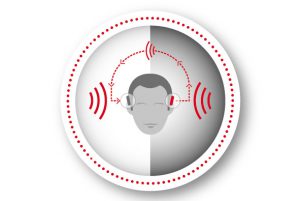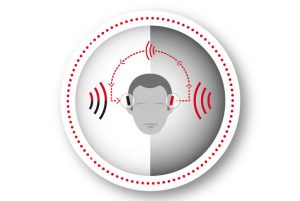Wireless CROS & BiCROS
What it is
The primax wireless CROS solution is designed for people who have normal hearing in one ear and unaidable hearing loss in the other. Sounds from the unaidable side are received by the microphones of a CROS Pure transmitter device, processed, and wirelessly transmitted to the side with normal hearing.
The primax wireless BiCROS solution is designed for people with un-aidable hearing loss in one ear and aidable hearing loss in the other. Sound from the unaidable side is received by the CROS Pure, processed and transmitted to the primax hearing aid on the other side. The primax hearing aid delivers the combined and amplified sound from both devices into the better ear.
 primax CROS
primax CROS primax BiCROS
primax BiCROSHow it works
The primax CROS/BiCROS solution is made possible by the cosmetically attractive CROS Pure transmitter, which can be paired with virtually any other primax instrument on the contralateral ear. Like other primax hearing aids, the CROS/BiCROS solution features natural sound quality with a low noise floor which is conducive to listening comfort, and in a BiCROS set-up, to understanding of soft speech. For wearers with normal hearing in the better ear (CROS), the importance of a low noise floor should not be overlooked. In fact, it is oftentimes a crucial factor in terms of spontaneous acceptance. The low noise floor is also a key differentiator between the primax CROS solution and similar existing products on the market.
The primax CROS/BiCROS solution features automatic, adaptive directionality for noisy situations, making speech understanding easier, and reducing listening effort. The CROS Pure directional microphones feature an innovative polar pattern focused to the front and skewed towards the side. This directional signal is then transmitted to the other side before the signal is either delivered to the ear alone in the CROS solution, or combined with the ipsilateral signal in the BiCROS solution. In other words, even in noisy situations, the CROS benefit is maintained, and does not significantly compromise battery life.
Fitting & Availablity
In monaural fittings, Connexx Eight makes a recommendation based on the audiogram if the wearer could be a CROS or BiCROS candidate. This only serves as a guideline, and the Hearing Care Professional HCP can choose a CROS/BiCROS fitting regardless of the Connexx recommendation. When a CROS/BiCROS solution is advisable, the CROS Pure is be fit to the side with the un-aidable hearing loss. The CROS Pure is then compatible with essentially any other wireless-enabled primax instrument fit on the better-hearing side. The selection of a BiCROS receiver/contralateral hearing aid should be based on the wearer’s hearing loss in the better ear and his listening needs in general. In a CROS solution, we recommend the receiver aid to be a RIC device featuring e2e wireless 3.0, and fit with an open dome to allow transmission of natural sound into the ear canal. An appropriate ERU length should be selected to ensure a secure fit in the ear. To simplify fittings for the HCP, the CROS Pure does not have to be programmed at any point, thanks to auto-pairing. By simply clicking on the Wireless CROS box, the two devices are automatically paired.
Like all other fittings, primax fit also provides an individualized first fit for BiCROS fittings. In addition to other gain and feature settings, the mixing point for the transmitted audio signal from the CROS Pure and the hearing aid side is fully configurable in Connexx.
Despite the fact that the Pure CROS transmitter does not require any programming, it is packed with technology. The signal that it transmits to the contralateral device is the output of an automatic, 6-situation classifiercontrolled, adaptive directional microphone, including wind noise reduction. The onboard volume control can be controlled together with the VC on the contralateral receiver aid. The CROS Pure is positioned at the ear using any mini-receiver. Since the CROS Pure does not provide any output, even acoustically non-working mini receivers can be used.
In a BiCROS set-up, all standard features of a monaural hearing instrument are available for the receiver aid. The hearing care professional also has the choice to set up a program in the BiCROS receiver aid which de-activates the CROS stream. This setting may be preferred by wearers in certain situations such as quiet, or if the wearer is in the car with the un-aidable side towards the car window.